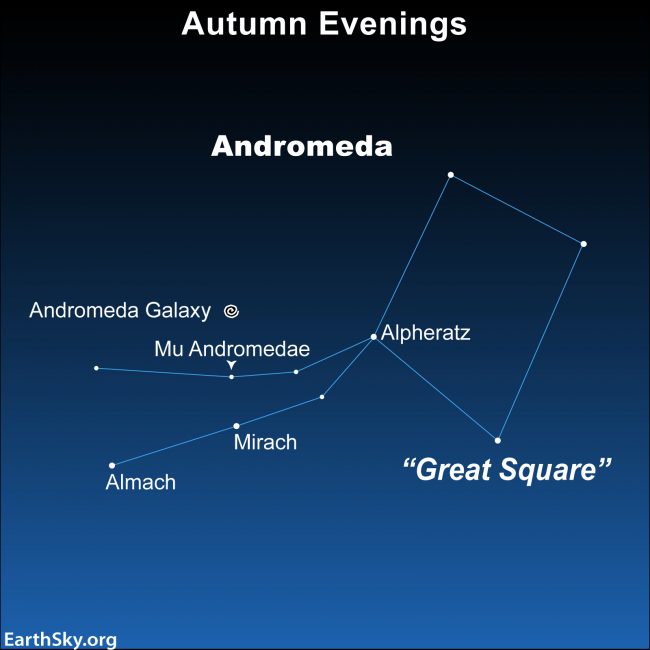
Almach is 4 stars
The constellation Andromeda the Princess is renowned for the Andromeda galaxy. But even a modest telescope will show another excellent target in Andromeda: the multiple star system Almach (Gamma Andromedae). It appears through a small telescope as one of the finest double stars in all the heavens. One component of this telescopic double appears golden, and the other component appears indigo blue. Further research has shown that Almach is really four stars.
Some double star aficionados believe Almach’s vibrancy of color even surpasses that of the star Albireo in the constellation Cygnus, generally regarded as the sky’s finest double star. In autumn, both Almach and Albireo are there for the viewing, so check them out and decide for yourself.
Try different eyepieces at your small telescope, to see which one gives you the most vivid view of this colorful double.
Today, it’s known that the smaller blue star is a triple star system, making Almach four stars in all. This quadruple star system is located an estimated 350 light-years away.

The 2024 lunar calendars are here! Best Christmas gifts in the universe! Check ’em out here.

Almach star-system science
German astronomer Johann Tobias Mayer was the first to report Almach or Gamma Andromedae as double in 1778. The main components of the star system are named Gamma1 Andromedae and Gamma2 Andromedae or Gamma Andromedae A and Gamma Andromedae BC. The apparent pair of contrasting stars appears to be around 10 arcseconds apart in the sky. The single star and the triple star system orbit each other with a period of around 4700 years.
The brighter component, Gamma1 Andromedae, shines at a magnitude of +2.26. It’s a K-type giant star. Compared to our sun, this star is 80 times bigger in radius, big enough to reach the orbit of Venus. It has a surface temperature of 4500 K (about 4200 C or 7600 F) and is 2,000 times more luminous than our sun with a rotational velocity of 17 km/s (about 10 mps).
Gamma2 Andromedae itself is a multiple star system with spectroscopic binaries Gamma Andromedae B and Gamma Andromedae C. These 5th and 6th magnitude dwarf binaries orbit each other in 63.7 years and are separated by barely 0.3 arcseconds. That translates to approximately 33 astronomical units (AU, or Earth-sun distances), comparable to the distance between our sun and the planet Neptune. The brighter star of the two, Gamma Andromedae B, is another binary system. Its companion is detectable only with a spectrograph. The two stars are very close and orbit each other in 2.7 days. The estimated mass for this triple star system is 8.7 solar masses. Gamma2 is thus a triple-star system, making Almach a quadruple-star system.
How to find the star Almach
In skylore, Almach marks the Princess Andromeda’s left foot. Star-hop to Almach from the Great Square of Pegasus, the signature star formation of Northern Hemisphere autumn.
Two streamers of stars fly outward from the Great Square, starting at the star Alpheratz. These streamers of stars are the constellation Andromeda.
Jump three stars over on the lower streamer to locate Almach. At 2nd-magnitude brightness, Almach shines pretty much on a par with the stars of the Big Dipper.
Almach shines relatively close to the famous variable star Algol in the constellation Perseus. When Algol shines at maximum brilliance, it matches Almach in brightness.
Bottom line: Almach looks single to the eye. But a small telescope transforms Almach into two colorful suns, one golden and the other blue. And astronomical research has revealed that one component is a triple star system, making the Almach system four stars in all.
Mirfak: Perseus’ brightest star
Enjoying EarthSky? Sign up for our free daily newsletter today!
The post Almach, a quadruple star system in Andromeda first appeared on EarthSky.
0 Commentaires